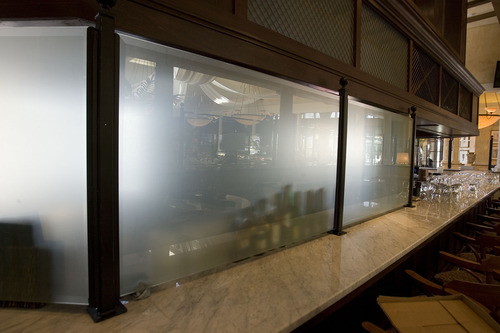This is an archived article that was published on sltrib.com in 2014, and information in the article may be outdated. It is provided only for personal research purposes and may not be reprinted.
The "Zion Curtain" at bars within Utah restaurants will remain, despite renewed attempts to tear it down that had gained more ground this year than many expected.
Because of opposition in the Senate, Rep. Kraig Powell, R-Heber City, has abandoned his HB285. It would have removed the 7-foot-2-inch opaque barrier that newer restaurants must have in bar areas so children can't see alcoholic beverages being mixed or poured.
"We had enough votes in the House to pass it," Powell said. But he never brought it up there after winning 8-7 committee approval after he proposed a compromise to allow restaurants either to keep the Zion Curtain or instead post notices on doors warning that they serve alcohol in public view. "But I never got any word back from any of the senators that they were willing to consider it," Powell said.
He added it wasn't worth the time for a probably long debate on the House floor as time is scarce at the end of the session and "we didn't think there was any chance the Senate would take it up."
Sen. John Valentine, R-Orem, confirmed Wednesday, "There really wasn't any support over here."
He said, "The biggest issue here in the Senate is that we have made so many changes over each year that we think we have the balance pretty close to right."
He said the Zion Curtain came out of a compromise in 2009 to help make clear the difference between bars and restaurants. "Bars no longer have a membership requirement, no longer have to have plastic barriers that you couldn't pass drinks across. So bars in Utah are just like bars everywhere else."
But Valentine said the deal included the Zion Curtain to make sure that restaurants were different, and focused on serving food.
"In Wyoming, where I stole the idea of the preparation area, has exactly the same language that we have," he said.
Both Valentine and Powell said a key reason the bill did not advance this year was opposition from the LDS Church. Before the session began, it issued a video and statement urging no changes in Utah liquor laws, including retaining the Zion Curtain.
"We may have lost a few votes in the House" because of that, Powell said.
Valentine said the church's position was key. "Candidly the capstone was when the LDS Church … came out in very strong support of the Senate's position and keeping the demarcation between what's a restaurant and a bar."
He added, "It helped bolster the position that, yes, the Senate position is one we're going to stay on."
Powell said he expects to see the issue arise again in the future. He was supported by tourism and restaurant officials who say the current system leads to illogical serving practices and does little to curb underage drinking, but was opposed by groups who argue removing the curtain will lead to a culture of acceptance of alcohol.
For example, Melva Sine, president of the Utah Restaurant Association, noted that only newer restaurants must have the Zion Curtain, putting them at a competitive disadvantage with older restaurants built before they were required and were grandfathered out of that rule.
She said rules allow all restaurants to display alcohol openly, so children see it. If a patron buys a bottle of wine or beer, restaurants are allowed to bring it and pour it into a glass at a table. But if patrons order a single glass of beer or wine, it must be poured behind the curtain and then delivered.
But Laura Bunker, president of United Families International, believes that "separate alcohol preparation areas are an invaluable part of the environment that discourages underage drinking in our state."
Powell said he is glad he pushed the issue to a hearing this year. "I'm at least satisfied that citizens felt like they were heard and kept this issue at the forefront again this year."



